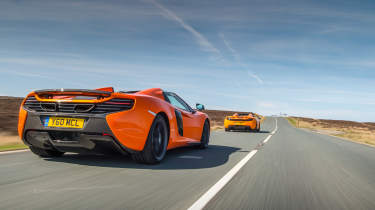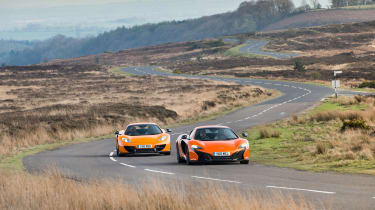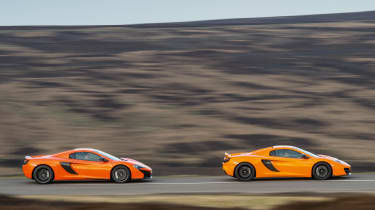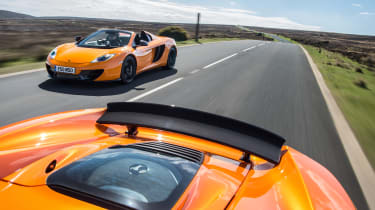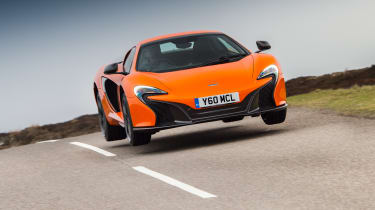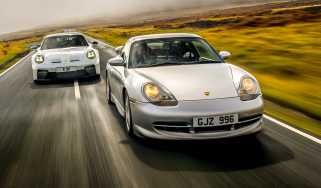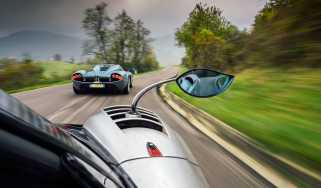McLaren 650S Spider vs McLaren 12C Spider review - what price progress?
Indistinguishable to many and very similar on the spec sheets, we find how far, if at all, the 650S moved the game on from the old 12C
‘How different can they all be?’ asked a car-savvy friend, nodding at the McLaren 650S Spider and McLaren 12C Spider but referring to the extended McLaren range. To be honest, I’ve had to do my homework. Back in 2011 I drove the original, the MP4-12C, and arriving back for my second stint at evo magazine I find there are swarms of the blighters. There are ‘Sports Series’ and ‘Super Series’ and ‘Ultimate Series’, but to the untrained eye they all look pretty much the same. During this test three people will ask if the 650S (the more orangey one) is the £866,000 P1...
Dive into the technical specs and you’ll find that beneath their unstressed skins, Sports and Super Series cars are created from the same essential ingredients: a carbonfibre tub, double-wishbone suspension all-round and a 3.8-litre twin-turbo V8 with a seven-speed dual-clutch transmission. Their skins differ, Sports being sheet-moulded compound, Supers carbonfibre, and so do their chassis: Sports models have physical anti-roll bars while Supers have ‘Proactive Chassis Control’, McLaren’s cross-linked active damper system that replicates the effect of physical anti-roll bars in cornering but leaves the wheels unlinked in a straight line for ride comfort. Outputs, meanwhile, ranged from 533bhp (540C) to 666bhp (675LT) before the McLaren 720S landed, and prices from £126,000 to £285,000, but when they’re all unmistakably supercars, you can’t blame people for not knowing one from another.
More reviews
It’s a relief that the latest Super Series car, the 720S , has an all-new look to bring some definition to the range. The 720S is the successor to the 650S, itself the successor to the 12C (the less orangey one) and thus a descendant of McLaren’s original multi-tasking supercar, the MP4-12C. It’s been quite a journey, and to find out just how far the Super Series has come and if there’s a discernible evolutionary trajectory, we’ve brought the 650S and 12C, both here in Spider form, to some of our favourite roads.
When McLaren announced the MP4-12C it boldly declared that it wasn’t going to compete with the established marques, it was going to teach them a lesson. In some ways it did, and the speed with which McLaren has established its credibility and expanded its range to fill numerous supercar niches is extraordinary. There has, of course, been learning and development along the way; few complex products arrive on the market, enjoy success and retire years later completely unchanged, whether they are vacuum cleaners or supercars. The MP4-12C was no exception: it quickly became simply the 12C, and even in the first months of production, there were changes afoot. We included the MP4-12C in eCoty 2011, based around the Portimão circuit in Portugal, and the car came with an unusual accessory – a chunk of the McLaren development team. They continued to fettle it during the test. Each day we’d borrow it for photos and driving and each day the dynamics were clearly not right. The steering lacked feel and was too light, and the handling and ride were an odd concoction; the ride was remarkably – arguably unnecessarily – cosseting for a supercar, but the handling suffered for it, being oddly detached from the road and prone to mild diagonal pitch sensations. Until, that was, on the final day, when whatever tune the engineers settled on was squirted into the dynamic-control module and the car was instantly, vastly improved.
In fact, it was so good that had it been like that from the start it might have stolen the win from the Porsche 911 GT3 RS 4.0. The suspension still neutralised awful, broken road surfaces, and the MP4 passed noiselessly over bumps and dips that ground bits off the undersides of the Ferrari FF and RS Porsche, but now you were connected to the car and road. Now you could exploit its ability and unleash more of its near-600bhp power more of the time, guide it confidently, revelling in the superb driving position and the panoramic view afforded by the wide, low-scuttled screen.
Right there and then, the MP4 felt like the new kind of supercar McLaren had promised us. That’s to say, a car that could cross a continent in comfort and then tear around a racetrack as fast as anything else. Except that back then it still felt a bit weird around Portimão’s challenging crests and curves. Oh, and every time you used the carbon-ceramic brakes the bite was so sudden you risked headbutting the steering wheel. And there were a few other issues too, including the Android-based IRIS infotainment system, which remained blank for the duration of the test.
Six years on, McLaren has clearly never let up on development. That said, if you’re not McLaren-savvy, five minutes in the car park will save much frustration later, because the switchgear is not always intuitive. Indeed, there’s plenty of opportunity for the 720S to move the human- machine-interface (HMI) experience on... Touchscreen but with hard key access? That’s the navigation system. Want to adjust the clock? That’s hidden in a stalk-activated submenu in the instrument cluster, not in the long Settings menu on the touchscreen. And the door-mirror adjuster? It took me an hour to find it on the move. It’s tucked behind the wheel, lit red and marked ‘P’ – for the parking mode, obviously.
I’ve always been irked by the mode switches for handling and powertrain, too, because they look cheap and because you can’t simply dial up the mode you want. Oh no, they don’t work unless you press the ‘Active’ button first, like a game of Simon Says. But I think I’ve figured that now. More later.
I feel fully acquainted with the dynamics of the 650S having driven it the best part of three hours north. The first thing that strikes you is how supple the ride is, how well it isolates you from the vagaries of the road surface and enables effortless long-distance coverage. There’s still plenty of MP4- 12C DNA in the ride. The last 40 minutes to the car park at Blakey Ridge on the North York Moors have been particularly invigorating, especially the road that heads up from Hutton- le-Hole. This has pocked surfaces, abrupt crests and flat, unsighted apices. The 650S doesn’t merely cope with this road, it smooths it out, fills in the dips and neutralises impacts. True, you can occasionally sense the MP4’s foibles in slightly odd reactions or movements, but switch the handling to Sport and these are reduced to trace effects, so you feel confident to let the big-lunged, turbo’d V8 breathe deep.
It’s a light-sounding engine like the Ferrari 488’s V8, the flat-plane crank synchronising power strokes, resulting in a sweet, four-cylinder-like note. It’s unmistakably turbocharged, more in the dizzying way the power and torque expand and escalate than for any response lag – there’s a moment before it gets going, but the slick dual- clutch gearbox is brilliantly responsive. McLaren says the biturbo motor is good for 641bhp (650 PS) and I don’t doubt it: the first time I stabbed the throttle to the stop, the intensity of the acceleration was shocking. The power piled in so hard and the rear tyres hooked up so completely that I imagined their sidewalls buckling like they do on dragsters, a sensation fostered by a hint of squirm from the rear.
Less than 20 minutes after parking up, the 12C arrives, giving us a chance to play spot the difference. This 12C is one of the last from 2013 and a McLaren 50th anniversary car too, so it has a big spec. This includes 650S-matching ceramic brakes behind slightly different design alloys that wear 650S-size Pirelli P Zeros: 235-section at the front, 305 at the rear. There’s also a redesigned front apron that brings increased downforce. Overall the design is more conservative than the 650S, but this limited-edition car looks much more supercar-like than the original MP4. To me, the MP4 looked too much like an identikit supercar created for an insurance advert, but McLaren’s design boss Frank Stephenson put that right on later models, replacing the plain headlamp design with small arcs imitating the company badge.
It’s even more difficult to tell the 12C and 650S apart from the inside, though. A red badge here, coloured stitching there... In fact, the most significant advantage the 650S has is that it comes with DAB radio. Still, there’ll be a distinct difference in the way they drive, won’t there?
Well, yes, but this 12C is more like the 650S than the MP4. This shouldn’t be a surprise because McLaren carried on developing the car and offered upgrades to customers of early cars. All of them are enjoyed by this last-of-the-line 12C, including the engine upgrade that raised the original MP4 output of 592bhp to 616bhp. And rather unexpectedly, between 6000 and 8000rpm, this 12C feels very nearly as crazy fast as the 650S.
There is clearly much shared character between these two cars, but it only takes a couple of miles to realise that there are lots of differences, too. And after a couple of days, the depth and detail of the improvements incorporated in the 650S show an understanding of what makes the car more exploitable and enjoyable. This is evolution. Project forward and you can see where the 720S needs to improve to move the Super Series on again.
The unexpected initial suppleness of the 650S is unexpected softness in the 12C, and while this gives the 12C the feeling of greater isolation from surface imperfections, it comes with some shake over sharper bumps – the slight aftershock when a damper doesn’t deal with a bump positively. There’s also an exaggeration of the odd effects felt in the 650S, namely unexpectedly free longitudinal and diagonal body movements, and even switched to Sport chassis mode, the 12C doesn’t sharpen up. It’s almost as if the car is air-sprung. As a result, you feel a little less comfortable exploiting the brutal, dramatic power delivery.
Another contributor to the 12C’s less hurried feel is its steering, which demands less effort and is less abuzz with feedback. To be honest, a lot of what comes through the wheel of this 650S is noise rather than useful feedback, so that’s no loss, but the lack of instant response is. Turn the wheel in the 12C and there’s a moment where nothing happens, almost as if the suspension needs to see some roll before it can react.
Not that the lack of physical roll bars in any way limits the absolute cornering ability of either car. Lateral grip and traction are extraordinary; traction especially so given the kick the twin-turbo V8 can deliver and the lack of a limited- slip diff. The way these cars stick in corners, the lateral G they create, makes me wary of turning off the traction control. When strong grip is broken mid-turn, the force a turbo engine is working against is gone and it can spool up double-quick, which means more power and more wheelspin and a wild slide where a moment before there was order.
The 650S corners so flat and so hard that it honestly doesn’t feel like it is ever going to break traction, even with the thump of 500lb ft of torque arriving at the seriously loaded rear tyres. I select Track handling and powertrain modes, lighting up the traction-off warning symbol, and after a few more runs I reckon I’ve found the spot to snap the throttle open for a slide. I brace and go for it but there is no jab of opposite lock required. Instead, the engine goes BAAARRRP! – an ignition cut torques down the V8 momentarily to maintain traction. TC not completely turned off, then. I’m just fine with that...
It’s now that I realise the logic behind the ‘Active’ button nestled between the two mode toggles. It’s not like the manettino on a Ferrari, but more akin to the M button on BMWs in that you can pre-program various vehicle settings, say Track handling with Sport powertrain performance, and a press of the Active button gets you there.
> McLaren Senna: everything you need to know
As well as being more dynamically composed than the 12C, there are other areas where the 650S is superior. While both iterations of the twin-turbo V8 are thrillingly inertia- free and rev-hungry, the 650’s has a stronger mid-range pick-up and so gets the car accelerating sooner. It’s also less vibratory and sweeter-revving, and smoother at idle, too. Ambling into town, both cars get heads turning before they heave into view – they have that supercar sound quality, that depth, that unmistakably potent growl. The 650S, with its optional sports exhaust, has a superb extra layer of sound, a hint of traditional but race-bred V8 that adds greatly to the sound quality, like good seasoning enhances flavour. There’s more turbo chuff in the 12C, but perhaps it’s just more audible because there’s less tailpipe content.
These are different experiences, then. The 12C has come a long way since its early MP4 days, drifting slightly from its original mission statement, becoming a little sharper, a little less cossetting, and all the better for it while still offering a uniquely McLaren take on the supercar theme. The 650S moves the idea on in what seem initially to be mostly subtle ways, but which longer exposure reveals are significant. It may not look that different, but the sportier edge to its dynamics and the fine-tuning that have gone into the 650S make it a much more satisfying and complete supercar.
There are things that would improve both cars and which are, therefore, things that the new 720S will hopefully address. As already mentioned, HMI is one, and a related issue that the new car appears to have addressed is the positioning of the gear-selector buttons on the central console: in the 12C and 650S to get to them you have to do an impression of a T rex. The 720S’s have moved further forward and hopefully are slicker to use than those of the 650S, which are more responsive than the 12C’s going from D to R and vice versa, making three-point turns less stressful. Manoeuvring from cold, both 12C and 650S can feel like they have slipping clutches, with lots of revs for not much movement, so improvement here would be welcome.

